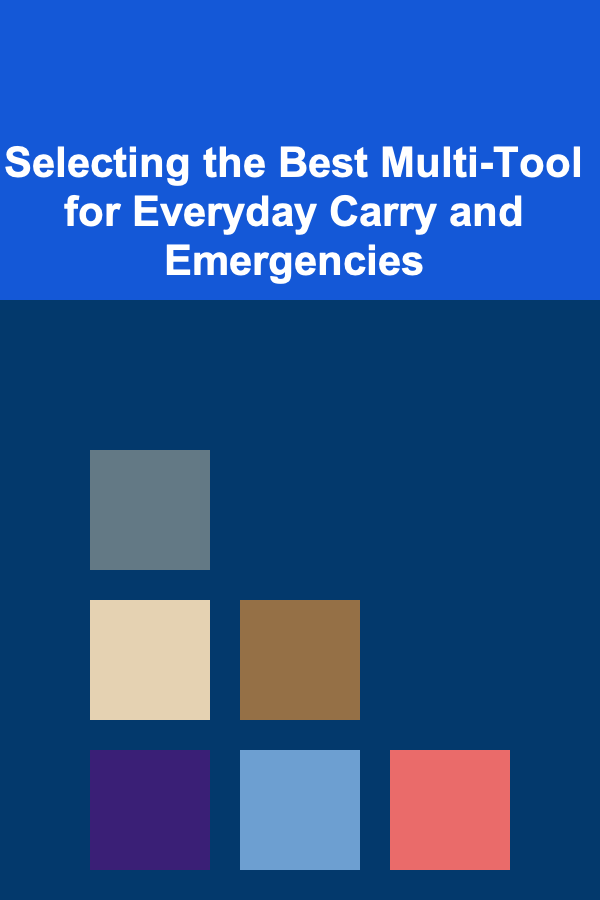
Selecting the Best Multi-Tool for Everyday Carry and Emergencies
ebook include PDF & Audio bundle (Micro Guide)
$12.99$7.99
Limited Time Offer! Order within the next:

The multi-tool: a compact, versatile instrument that encapsulates a toolbox within a single, pocketable device. For everyday carry (EDC) enthusiasts and emergency preparedness advocates alike, a well-chosen multi-tool is an invaluable asset. It offers a practical solution for a myriad of tasks, from tightening screws on the go to providing essential functionalities in unexpected situations. However, the sheer variety of multi-tools available on the market can make selecting the "best" one a daunting task. This article delves into the key considerations, functionalities, and quality factors to help you choose the ideal multi-tool for your specific needs and circumstances.
Understanding Your Needs and Use Cases
Before diving into specific models and features, it's crucial to define your intended use cases. Asking yourself honest questions about how you plan to use the multi-tool will greatly narrow down your options and ensure you select a tool that truly complements your lifestyle and preparedness strategy.
Everyday Carry (EDC) Applications:
Consider the typical tasks you encounter on a daily basis. Do you frequently need to open boxes, tighten loose screws, or perform minor repairs? Perhaps you work in an environment where having a small blade or pliers readily available would be beneficial. If your EDC needs are relatively light-duty, a smaller, more streamlined multi-tool might suffice.
- Opening packages and letters: A small blade, scissors, or a dedicated package opener can be invaluable.
- Tightening screws: A variety of screwdriver bits (Phillips, flathead, Torx) is essential for everyday maintenance.
- Making quick fixes: Pliers, wire cutters, and a small saw can handle minor repairs around the home or office.
- Opening bottles and cans: A bottle opener and can opener are classic multi-tool features.
- General cutting tasks: A blade is useful for a wide range of everyday tasks, from cutting cordage to trimming loose threads.
Emergency Preparedness Scenarios:
Emergency situations demand a different level of functionality and durability. Consider scenarios such as power outages, natural disasters, or vehicle breakdowns. In these situations, a multi-tool with more robust features and a greater emphasis on survival-oriented tools becomes essential.
- Cutting through seatbelts: A seatbelt cutter or a strong, serrated blade can be life-saving in a car accident.
- Breaking glass: A glass breaker (often made of tungsten carbide) can provide a crucial escape route from a vehicle or building.
- Fire starting: Some multi-tools include a ferro rod and striker for creating sparks to ignite tinder.
- Signaling for help: A whistle or a reflective surface can be used to attract attention.
- First aid: While a multi-tool is not a substitute for a dedicated first-aid kit, some models include tweezers or other basic tools that can be helpful for minor injuries.
- Repairing equipment: In an extended emergency, the ability to repair broken equipment or create makeshift tools can be critical. Robust pliers, a saw, and a file are valuable assets.
- Shelter building: A saw and a blade can be used to cut branches and other materials for building a temporary shelter.
Lifestyle and Occupation:
Your lifestyle and occupation will also influence your multi-tool needs. An outdoor enthusiast might prioritize tools like a saw, a fire starter, and a map scale, while a tradesperson might require more robust pliers, wire strippers, and specialized screwdriver bits. A person working in an office might prioritize a small form factor and tools for minor office repairs.
Key Features and Functionalities to Consider
Once you have a clear understanding of your needs, you can begin to evaluate the specific features and functionalities that are most important to you. Multi-tools offer a wide range of tools, from basic necessities to specialized functions. Consider the quality of the tools, their accessibility, and their overall durability.
Pliers: The Heart of Many Multi-Tools
Pliers are often considered the core function of a multi-tool. Look for pliers that are strong, durable, and comfortable to use. Important considerations include:
- Type of Pliers: Needle-nose pliers are useful for delicate work, while regular pliers offer more gripping power. Some multi-tools feature both.
- Construction: Look for pliers that are made from high-quality steel and are properly aligned.
- Comfort: The handles should be comfortable to grip, even for extended periods. Some multi-tools offer textured or contoured handles for improved grip.
- Wire Cutters: Integrated wire cutters are a common and useful feature. Look for hardened cutters that can handle a variety of wire gauges. Some offer replaceable cutting edges.
- Wire Strippers: Some multi-tools include wire strippers for stripping insulation from wires.
Blades: The Cutting Edge
The blade is another essential component of a multi-tool. Consider the blade's size, shape, steel type, and locking mechanism.
- Blade Size and Shape: A longer blade is useful for larger cutting tasks, while a shorter blade is more convenient for EDC. A drop-point blade is versatile for a variety of tasks, while a sheepsfoot blade is safer for tasks where you don't want to accidentally pierce something.
- Steel Type: Higher-quality steel will hold an edge longer and resist corrosion better. Common steel types include stainless steel (e.g., 420HC, 154CM) and carbon steel (e.g., D2). Stainless steel is generally easier to maintain, while carbon steel can be sharpened to a finer edge.
- Locking Mechanism: A secure locking mechanism is crucial for safety. Common locking mechanisms include liner locks, frame locks, and back locks. Ensure the lock is easy to operate and reliable.
- Serrated vs. Plain Edge: A serrated edge is useful for cutting through tough materials like rope or seatbelts, while a plain edge is better for clean, precise cuts. Some multi-tools offer a combination blade with both a serrated and a plain edge.
Screwdrivers: Turning the Tide
Screwdrivers are essential for everyday maintenance and repairs. Consider the variety of bits offered and the durability of the driver.
- Bit Selection: Look for a selection of Phillips, flathead, and Torx bits to cover a wide range of screw types. Some multi-tools offer interchangeable bit sets for greater versatility.
- Bit Driver Type: Some multi-tools have a dedicated bit driver, while others use the plier head as a driver. A dedicated bit driver is generally more comfortable and provides better leverage.
- Magnetic Retention: A magnetic bit holder helps to keep the bits securely in place.
- Durability: The screwdriver bits and the driver itself should be made from durable materials to withstand repeated use.
Saws: Cutting Through Obstacles
A saw can be a valuable asset for outdoor activities and emergency situations. Consider the saw's size, tooth pattern, and cutting ability.
- Size: A longer saw will cut faster, but a shorter saw is more compact.
- Tooth Pattern: A coarse tooth pattern is suitable for cutting wood, while a finer tooth pattern is better for cutting metal.
- Cutting Ability: Consider the types of materials you are likely to cut. Some saws are designed specifically for cutting wood, while others can handle metal or plastic.
Other Useful Tools: Expanding Functionality
Beyond the core functions, many multi-tools offer a variety of other useful tools, such as:
- Bottle Opener: A classic and often-used feature.
- Can Opener: Another classic and practical tool.
- Awl: Useful for punching holes in leather, wood, or other materials.
- File: Useful for shaping metal or wood.
- Ruler: Useful for measuring small distances.
- Scissors: Useful for cutting paper, fabric, or other light materials.
- Magnifying Glass: Useful for reading small print or examining objects closely.
- Fire Starter: A ferro rod and striker can be used to create sparks to ignite tinder.
- Glass Breaker: A tungsten carbide tip can be used to break glass in an emergency.
- Seatbelt Cutter: A dedicated seatbelt cutter can quickly and safely cut through a seatbelt.
- Whistle: Useful for signaling for help.
- LED Light: An integrated LED light can be useful for illuminating dark areas.
Factors Influencing Your Choice
Beyond specific features, several other factors will influence your multi-tool selection. These include size and weight, ergonomics, build quality, brand reputation, and budget.
Size and Weight: Striking the Right Balance
The size and weight of a multi-tool are critical considerations, especially for EDC. A multi-tool that is too large or heavy will be uncomfortable to carry and less likely to be used. However, a multi-tool that is too small may not offer the functionality you need. Strive for a balance between portability and functionality.
- Pocket-Friendly Size: Consider the size of your pockets and the comfort of carrying the multi-tool throughout the day.
- Weight Considerations: A lighter multi-tool will be easier to carry, but it may also be less durable.
Ergonomics: Comfort and Ease of Use
Ergonomics refers to the design of the multi-tool and how it feels in your hand. A well-designed multi-tool will be comfortable to use, even for extended periods. Consider the following factors:
- Handle Design: The handles should be comfortable to grip and provide adequate leverage.
- Tool Accessibility: The tools should be easy to access and deploy, even with gloves on.
- One-Handed Operation: Some multi-tools can be operated with one hand, which can be a significant advantage in certain situations.
Build Quality and Materials: Durability and Longevity
The build quality and materials used in a multi-tool are critical for its durability and longevity. Look for multi-tools made from high-quality steel and with solid construction.
- Steel Quality: The steel used for the blades, pliers, and other tools should be durable and corrosion-resistant.
- Construction: The multi-tool should be well-assembled and feel solid in your hand. Check for loose parts or excessive play.
- Finish: The finish should be durable and resistant to scratches and corrosion.
Brand Reputation and Warranty: Trust and Assurance
Choosing a multi-tool from a reputable brand can provide assurance of quality and reliability. Look for brands with a long history of producing high-quality tools and a strong reputation for customer service. A good warranty can protect your investment in case of defects or malfunctions.
Budget: Balancing Cost and Value
Multi-tools range in price from inexpensive models to high-end professional tools. Set a budget and consider the features and quality you can expect for that price. Remember that a higher price doesn't always guarantee better quality, but it often indicates a higher level of craftsmanship and materials.
Popular Multi-Tool Brands and Models
Several brands have established themselves as leaders in the multi-tool market. Here are some of the most popular and well-regarded brands, along with some of their notable models:
Leatherman: The Industry Standard
Leatherman is arguably the most well-known and respected multi-tool brand. They offer a wide range of models to suit different needs and budgets. Leatherman is known for its high-quality construction, innovative designs, and excellent warranty.
- Leatherman Wave Plus: A classic and versatile multi-tool with a wide range of features, including pliers, blades, screwdrivers, and more. It's a popular choice for EDC and general use.
- Leatherman Surge: A larger and more robust multi-tool designed for heavy-duty use. It features larger pliers, longer blades, and replaceable wire cutters.
- Leatherman Skeletool CX: A lightweight and minimalist multi-tool with essential features, including pliers, a blade, and a bit driver. It's a great option for EDC when weight is a concern.
- Leatherman Free P4: Innovative magnetic architecture allows for smooth, one-handed tool deployment. Features a full complement of tools and ergonomic design.
Gerber: Rugged and Reliable
Gerber is another well-respected multi-tool brand known for its rugged designs and durable construction. Gerber multi-tools are often popular with military personnel and outdoor enthusiasts.
- Gerber MP600: A reliable and durable multi-tool with one-handed opening pliers. It's a popular choice for military and law enforcement.
- Gerber Center-Drive: Features a unique center-axis screwdriver design for improved torque and a longer driver reach. Offers excellent leverage.
- Gerber Dime: A compact and lightweight multi-tool with essential features, including pliers, a blade, scissors, and a bottle opener.
Victorinox: The Swiss Army Knife Legacy
Victorinox, the maker of the iconic Swiss Army Knife, also produces a range of excellent multi-tools. Victorinox multi-tools are known for their high-quality construction, precision engineering, and versatile functionality. While known for their folding knife designs, their SwissTool line represents a strong competitor in the multi-tool market.
- Victorinox SwissTool Spirit X: A sleek and ergonomic multi-tool with a wide range of features, including pliers, blades, screwdrivers, and more. It's known for its comfortable grip and smooth operation.
- Victorinox SwissTool: A robust and durable multi-tool with similar functionalities to the Spirit X but with a more traditional design.
SOG: Innovative Designs and Tactical Focus
SOG (Studies and Observations Group) specializes in innovative and tactically-oriented multi-tools. Their designs often incorporate unique features and are built for demanding environments. Their compound leverage pliers offer significant gripping power.
- SOG PowerAssist: Features assisted opening blades and compound leverage pliers for increased gripping power.
- SOG PowerLock: A durable multi-tool with compound leverage pliers and a variety of useful tools.
Maintenance and Care: Keeping Your Multi-Tool in Top Condition
To ensure your multi-tool lasts for years to come, it's important to perform regular maintenance and care. This includes cleaning, lubricating, and sharpening the tools.
- Cleaning: After each use, clean the multi-tool with a damp cloth to remove dirt and debris. For stubborn dirt, use a mild soap and water solution.
- Lubrication: Lubricate the moving parts of the multi-tool with a light oil or lubricant. This will help to keep the tools operating smoothly and prevent corrosion.
- Sharpening: Sharpen the blade regularly to maintain its cutting ability. Use a sharpening stone or a dedicated blade sharpener.
- Storage: Store the multi-tool in a dry place to prevent corrosion. A sheath or pouch can help to protect the multi-tool from damage.
Conclusion: Choosing the Right Tool for the Task
Selecting the best multi-tool for EDC and emergencies is a personal decision that depends on your individual needs, preferences, and budget. By carefully considering the factors outlined in this article, you can narrow down your options and choose a multi-tool that will serve you well for years to come. Remember to prioritize quality, durability, and functionality over price, and don't be afraid to invest in a multi-tool that will provide you with the peace of mind knowing you're prepared for whatever challenges life throws your way. A well-chosen multi-tool is more than just a collection of tools; it's a symbol of self-reliance, resourcefulness, and preparedness.
Reading More From Our Other Websites
- [Organization Tip 101] How to Create a Vision Statement for Your DIY Journey
- [Organization Tip 101] The Best Backyard Fire Pit Kits for Every Budget
- [Home Storage Solution 101] How to Organize Your Closet by Using the Right Storage Solutions
- [Home Cleaning 101] How to Clean Your Home When You Have Small Kids
- [Paragliding Tip 101] Weather Woes: Emergency Strategies for Unexpected Storms While Paragliding
- [Home Maintenance 101] How to Perform Regular Appliance Maintenance to Extend Their Lifespan
- [Rock Climbing Tip 101] Gear Up: A Complete Checklist for Lead Climbing Success
- [Home Holiday Decoration 101] How to Design and Hang Eye-Catching DIY Holiday Banners for Any Room
- [Organization Tip 101] What Should You Know About Organizing Sports Equipment?
- [Organization Tip 101] How to Document Your Seasonal Changes for Personal Reflection

How to Organize Your Sewing Supplies for Creative Projects
Read More
How to Stage Your Home for Minimalist Style
Read More
How to Use Rugs to Transform Your Space on a Budget
Read More
Mastering Software Engineering: Essential Skills for Building Scalable Applications
Read More
How to Profit from Intellectual Property
Read More
10 Tips for Overcoming Procrastination with a Writing To-Do List
Read MoreOther Products

How to Organize Your Sewing Supplies for Creative Projects
Read More
How to Stage Your Home for Minimalist Style
Read More
How to Use Rugs to Transform Your Space on a Budget
Read More
Mastering Software Engineering: Essential Skills for Building Scalable Applications
Read More
How to Profit from Intellectual Property
Read More